Watercolor Greeting Card – Watch the Video!
The year is coming to an end, and it’s time to celebrate. Thank you for this year, my readers and students!
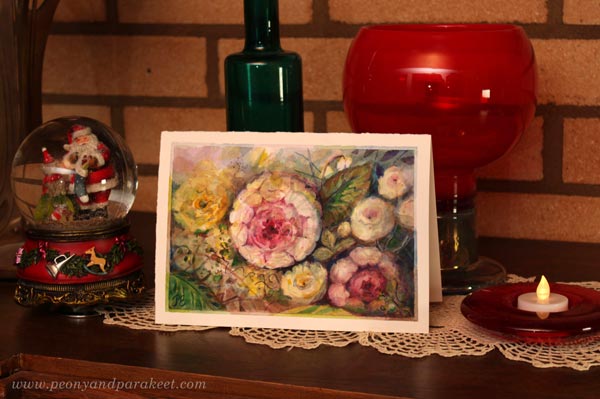
My gift to you comes in the form of a video. Let’s paint flower cards for everyone celebrating in the coming year! The following watercolor greeting card video is especially a bonus for all who have taken the latest course Freely Grown where I give more detailed advice.
Watercolor Greeting Card – Watch the Video!
In this video, I not only paint the greeting card but talk about art-making in general. I hope that the video inspires you to keep creating, and if you are not currently creating anything, there’s a short speech for you too!
The paper used for the card: Arches Hot Press watercolor paper, thickness 300 g/m2, 140 lb.
I mostly use three brushes: one flat, and two thin brushes for details. I also use a small and sturdy round brush for removing the paint. When you have a good-quality watercolor paper, you can rub it quite heavily. Use a cotton cloth to remove water after rubbing and then, let dry well before painting over.
In the video, I mention the botanical artist Marianne North. See her paintings here!
Happy Holidays and Happy New Year!
This is the last blog post of 2023. After a short break, we will meet again next year.
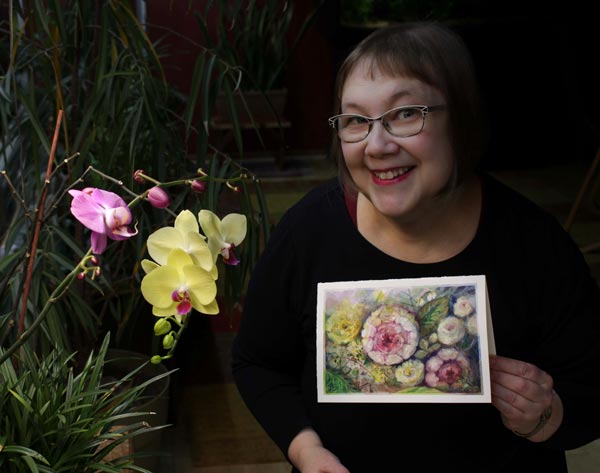
I hope you will have a wonderful time with your close ones, and of course, I hope you will spend some time with art-making as well!
Writing About Art
This week is dedicated to writing about art. I tell how I write these blog posts, and why it’s beneficial to write about art.

See more pics of this piece in the Taiko online art store!
How I Write a Blog Post
I have been writing these blog posts for years directly in English, so, in a language foreign to me. I wanted to develop my language skills and it seemed like the best method, even if the expression was sometimes limited. This year, I started to write these stories in Finnish first. Once the Finnish text is done, I translate it into English. I edit the translation 2-4 times before the story is finished.
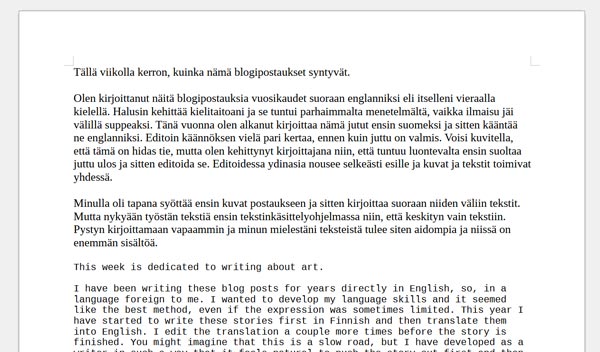
You might imagine that this is a slow road, but I have developed as a writer in such a way that it feels natural to push the story out first and then edit it. When editing, the subject becomes more clear and the images and texts work better together.
I love the interaction between two languages.
When I write in Finnish, I’m already thinking about English. In Finnish, passive constructions and long expressions are used a lot. I’ll try to be more concise right at the beginning. Words and expressions also differ. In Finnish, I can easily get a relaxed and even humorous tone, but I can’t translate it into English, and neither can machine translators. However, I don’t mourn the matter, I think that the union of two languages is like a marriage: both have to give way.

Joyce Carol Oates talks about having a journal separate from the stories and novels. The journal could be more honest and raw, and use a little different style than what ends in the publication. For me, the Finnish script is a bit like that – a stream of thoughts that gets refined with edits.
The Relationship Between Images and Text
I used to enter the images into the post first and then write the texts directly between them. But these days I work in a word processor so that I only focus on the text. I can write more freely and the texts become more authentic and have more content. I can then fit the images between the text and add captions if needed.
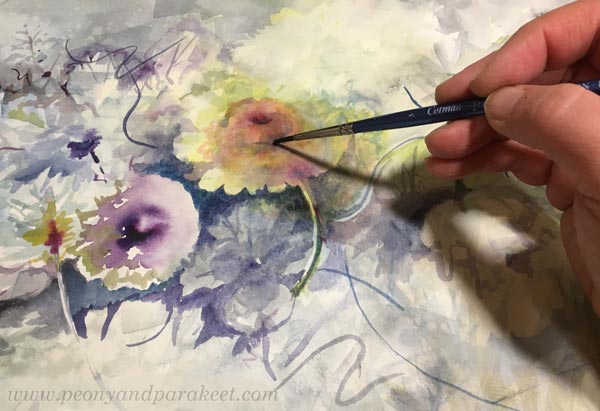
Although I decide the topic of a blog post when I start writing it, most of the pictures exist before the text. I strive to always have new photos and I often plan the collection of images weeks in advance. Since this blog is about art and is aimed at visual people, I need lots of pictures. I want to inspire the reader to make art, so the pictures need also express the process, and not just finished works.
Writing Moves Art Forward
Nowadays, many have left blogging and moved to posting on Facebook or Instagram or uploading videos to YouTube. I too write regularly on my Facebook page and Instagram account. Every now and then I also make a video on YouTube.
But writing is magical. When you write a longer story, you don’t just write to others but to yourself too.
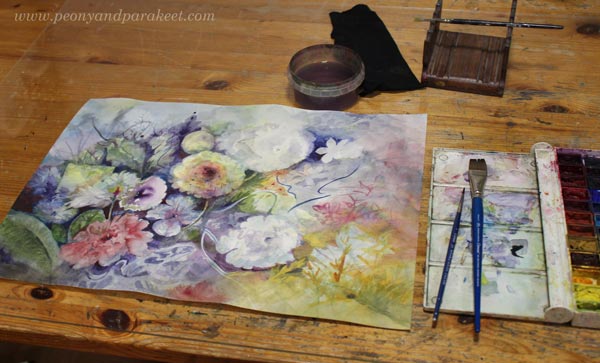
And I am not the only one who thinks that way. Last spring, I participated in an artist coaching program by the Finnish Art Agency, where the coach wanted us to write regularly about our art. She emphasized that working with words is important because visual artists often need to tell about their art.
Writing About Art is Almost Similar to Talking About Art
I believe that all who create art also want to talk about it. It’s just very difficult sometimes. Pictures go to the other side of the words and the ideas get mixed up.

Talking about your art can also feel like pompous boasting, even if the recipient would be interested. Long art stories can also bore the listener if she is not as deep in creating. The same applies to writing, you can feel pretentious or be afraid to bore someone, but when you write it’s easier to notice when you’re stuck and repeating yourself.
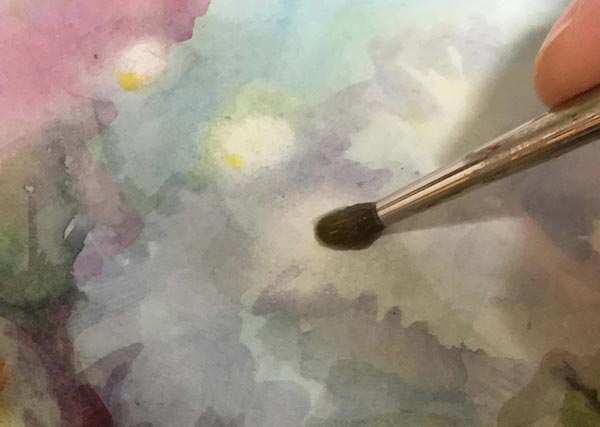
My art has not only developed by drawing and painting diligently. It evolves every time I write about it. It has developed by blog posts, manuscripts for classes, short video posts, and even description texts, where I have to briefly tell who I am or what inspired me to create a certain piece.
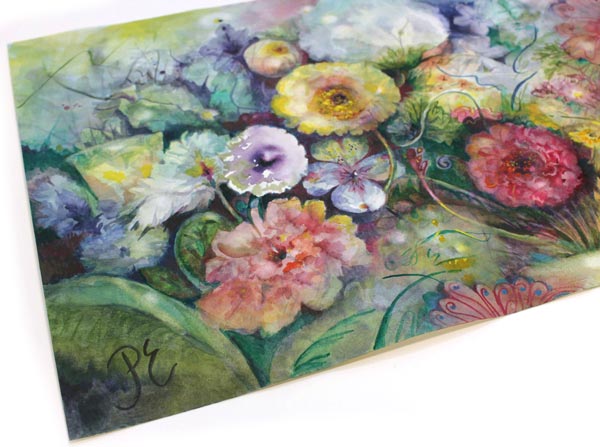
Writing brings out problems. You have to focus on what you really want to say and tell who you really are. There will be a temptation to find words that sound great but not say the truth. But if you can overcome the lure of meaningless words, creativity in you wakes up.

I have noticed that when I can put my wishes and ideas into words, they begin to appear in my paintings. Our creativity strives to fulfill our wishes if it can read them. So, that’s why I am writing about art weekly. Thank you for making me do that!
Do you write – or plan to write – about your art? Tell us more!
How to Create Comforting Art
This blog post is for you who want to spread more joy through your art, and make your art more comforting and captivating.

I am listening to an interesting course on writing. It’s Neil Gaiman Teaches the Art of Storytelling. Writing and making a picture have a lot in common. When you look at your piece, can you find a story – so, a conflict and a solution?
Conflict Creates More Comfort
Neil Gaiman says that beginning writers leave conflict out of their stories. And that it’s the conflict that makes the story interesting. The same goes for the picture. Beginner artists usually want to use only happy colors and draw or paint only beautiful and joyful things.
I too want to make comforting art – something that takes me to a softer world right in the beginning and that will lift the viewer’s mind when finished. But the conflict must still be allowed because first showing it, and then finding a solution for it, creates comfort and happiness.
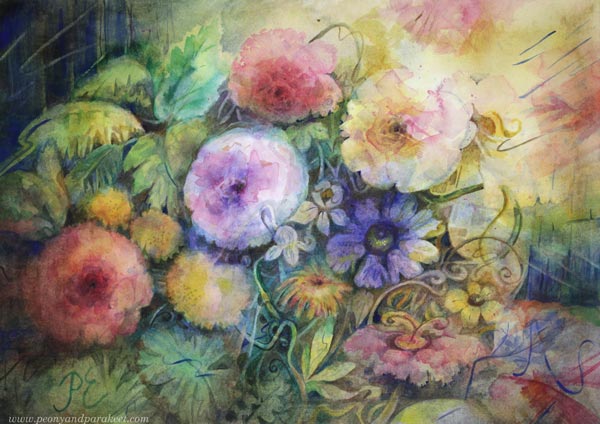
Purchase this painting via the Taiko art store!
For example, in this watercolor painting above, the flowers have run indoors because it has started to get windy and rain a little.
Imagine how they first evaluate the houses: “Where would we be welcomed the most?” And then they would push through the darkest window and settle on the windowsill close to each other.
Imagine stepping into that room and seeing shattered glass and feeling unpleasant coldness. But then the colorful flowers would bend towards you. What a pleasant surprise to receive in these windy times!

When I painted this, I wanted to protect myself from the winds of the world. I started with the flowers, but the painting only came true when the wind joined in.
Overcoming Difficulties Brings Comfort
For me, the most comforting art is the one where difficulties are overcome. For example, in this painting, the flowers have experienced loss, but are still ready to take risks again.

Build Different Characters
Neil Gaiman says that his stories are largely in the hands of the characters. Also in painting, you have to identify the main characters. Blots easily turn into flowers, but don’t leave it at that! Make small changes to the shapes so that the personality of each flower comes out. Often it’s a very small adjustment that a beginner easily ignores as insignificant. The skill of building an expression for a form no matter what it represents develops with making.
Strong characters and an understanding of the place where everything happens create a story in the picture. My main characters are strong-minded and independent and the conflict is often a fight against wild conditions.
For example, winter has arrived here, but the flowers stubbornly decide to turn the clock back to a warmer time. In this conflict, the flowers lose their color to stay alive.
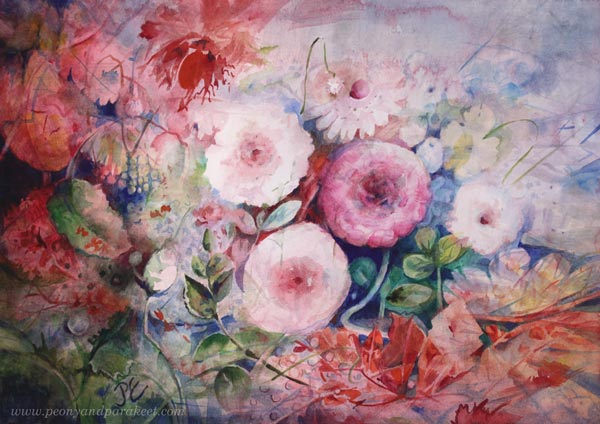
Sometimes what feels good at first can break down in the long run. Can a flower live only in light? Don’t we get a better understanding of our outlines and boundaries in the shadows?

On the other hand, when life has been nothing but darkness and the colors have faded, the power of light enables a fast recovery.

Observe the Surroundings with Empathy and Imagination
As a director of disaster films, I am inspired by the survivors around me. This autumn, I listened to the lily of our new pond, who described how boldly she would soon bloom. Fall progressed and my suspicion grew. But just before the big storm, the bud opened for one day.
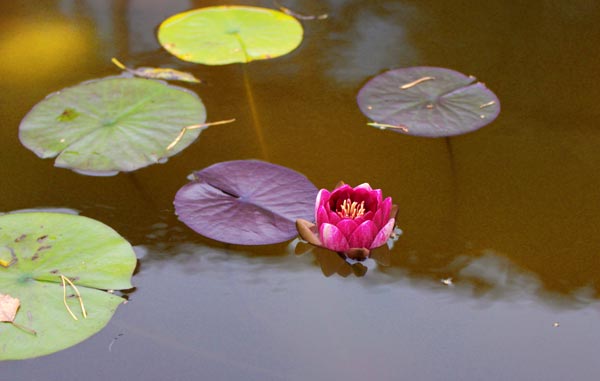
You can survive of the deep waters – even only for a moment!

The world of inanimate objects is also full of ideas when you use your imagination.
For example, wallpaper is one of the most pathetic things I know. The flowers are glued in place, but they still see and hear everything. If they were released, a lot of pent-up energy would be present. The silent and motionless wall flowers would party around the room. They had been thirsty for life for a long time.

Isn’t that what happens when a person starts creating art? The frenzy inside her finally gets out!
Flower Time – Watercolor Video
This week, I have a treat for you – a free video about painting flowers. In the video, I claim:
“When you create art, sometimes it’s adventurous “bird time,”
and sometimes driven by the need for beauty and comfort, so “flower time.”

I believe that we are not only inhabited by an inner bird but also by inner flowers. At the adventure, the flowers are only seen as passive decorations. But when you get friends with the flowers, you notice that they are active characters who like to get together. The inner bird is a hermit adventurer, but flowers tell the common story. This togetherness is also what we need as humans.
“Janonsa sammuttaneet” could be translated to “those who have quenched their thirst.” In this painting, I thought about wallpaper and how its flowers jump from the wall to quench their thirst.
Flower Time – Watch the Video!
Everytime I see a bird flying across a landscape, I feel the need to paint something big, dramatic, and immersive. Art invites us to fly high and see far – to live the adventurous life of a brave bird. Imagination is our inner bird that wants to experience new things and move forward … Watch the video!
More instructions for flowers in watercolor: Buy my newest course Freely Grown!
Flower Portraits
I used to think of flower paintings as still lifes, but now I look at them as portraits. The delicacy of flowers makes my inner bird rest and roots me in a comforting life. From the inner bird’s point of view, there are always new sceneries to travel, and the world is never enough. But from the flowers’ point of view, it’s always good to look close to one’s heart and express that we are enough.

“Valosta voimaantuneet” is Finnish and means “Empowered by Light.”
Think about birds and flowers as symbols for two kinds of art – the other is adventurous and escape-seeking, and the other is easier to digest and connection-seeking.
What do you think of this? Do you have more “bird time” or “flower time?” Leave a comment!